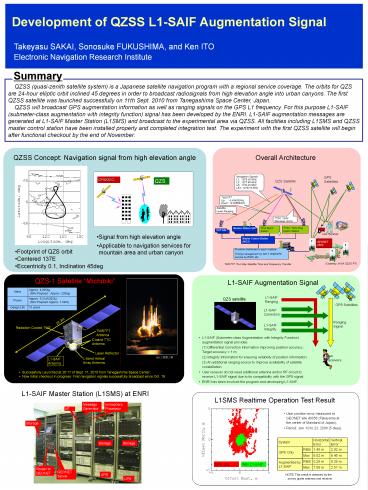Development of QZSS L1-SAIF Augmentation Signal - PowerPoint PPT Presentation
1 / 1
Title:
Development of QZSS L1-SAIF Augmentation Signal
Description:
Development of QZSS L1-SAIF Augmentation Signal Takeyasu SAKAI, Sonosuke FUKUSHIMA, and Ken ITO Electronic Navigation Research Institute Summary – PowerPoint PPT presentation
Number of Views:60
Avg rating:3.0/5.0
Title: Development of QZSS L1-SAIF Augmentation Signal
1
Development of QZSS L1-SAIF Augmentation Signal
Takeyasu SAKAI, Sonosuke FUKUSHIMA, and Ken
ITO Electronic Navigation Research Institute
Summary
QZSS (quasi-zenith satellite system) is a
Japanese satellite navigation program with a
regional service coverage. The orbits for QZS are
24-hour elliptic orbit inclined 45 degrees in
order to broadcast radiosignals from high
elevation angle into urban canyons. The first
QZSS satellite was launched successfully on 11th
Sept. 2010 from Tanegashima Space Center, Japan.
QZSS will broadcast GPS augmentation
information as well as ranging signals on the GPS
L1 frequency. For this purpose L1-SAIF
(submeter-class augmentation with integrity
function) signal has been developed by the ENRI.
L1-SAIF augmentation messages are generated at
L1-SAIF Master Station (L1SMS) and broadcast to
the experimental area via QZSS. All facilities
including L1SMS and QZSS master control station
have been installed properly and completed
integration test. The experiment with the first
QZSS satellite will begin after functional
checkout by the end of November.
QZSS Concept Navigation signal from high
elevation angle
Overall Architecture
Navigation Signals L1 1575.42 MHz L2 1227.60
MHz L5 1176.45 MHz LEX 1278.75 MHz
GPS Satellites
GPS/GEO
QZS
QZS Satellite
TWSTFT Up 4.43453GHz Down 12.30669GHz
Satellite Laser Ranging
TTC / NAV Message Uplink
TTC / NAV Msg Uplink Station
Time Mgmt Station
Monitor Station NW
SLR Site
User Receiver
- Signal from high elevation angle
- Applicable to navigation services for mountain
area and urban canyon
Master Control Station (MCS)
GEONET (GSI)
- Footprint of QZS orbit
- Centered 137E
- Eccentricity 0.1, Inclination 45deg
Function distributed in each institute Timing
management by NICT, WADGPS service by ENRI, etc.
(Courtesy JAXA QZSS PT)
TWSTFT Two Way Satellite Time and Frequency
Transfer
QZS-1 Satellite Michibiki
L1-SAIF Augmentation Signal
Mass Approx. 4,000kg (NAV PayloadApprox. 320kg)
Power Approx. 5.3 kW (EOL) (NAV Payload Approx. 1.9kW)
Design Life 10 years
L1-SAIF Ranging
QZS satellite
GPS Satellites
L1-SAIF Correction
Ranging Signal
25.3m
L1-SAIF Integrity
Radiation Cooled TWT
TWSTFT Antenna
- L1-SAIF (Submeter-class Augmentation with
Integrity Function) augmentation signal provides - (1) Differential Correction information
improving position accuracy Target accuracy 1
m - (2) Integrity information for ensuring
reliability of position information - (3) An additional ranging source to improve
availability of satellite constellation. - User receiver do not need additional antenna
and/or RF circuit to receive L1-SAIF signal due
to its compatibility with the GPS signal - ENRI has been involved the program and developing
L1-SAIF.
C-band TTC Antenna
Laser Reflector
User Receivers
(c) ?????
L-band Helical Array Antenna
L1-SAIF Antenna
- Successfully Launched at 2017 of Sept. 11, 2010
from Tanegashima Space Center - Now initial checkout in progress First
navigation signals successfully broadcast since
Oct. 19.
L1-SAIF Master Station (L1SMS) at ENRI
L1SMS Realtime Operation Test Result
- User position error measured at GEONET site 40058
(Takayama at the center of Mainland of Japan) - Period Jan. 19 to 23, 2008 (5 days).
NOTE This result is obtained by the survey grade
antenna and receiver.































